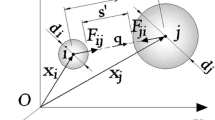Abstract
A system of two nonlinear first-order differential equations is analyzed that describe the dynamics of the interaction between lymphocytes and tumor cells in the body. The model utilized takes into account the effect of a magnetic field. A concept is formulated concerning the analogy between the behavior of microparticles (atoms, molecules) in a medium with traps (in materials science) and the behavior of lymphocytes in living tissue containing tumor cells (in oncology). It is established that the tools of the qualitative theory of differential equations (analogous to those applicable to oncology) can be effective in analysis of transport and transformations in materials science.
Similar content being viewed by others
References
A. I. Raichenko, “Comparative analysis of one-particle mathematical models in materials science and oncology. I. Mathematical models,” Poroshk. Metall., Nos. 11–12, 72–78 (2005).
C. DeLisi and A. Rescigno, “Immune surveillance and neoplasia. I. A minimal mathematical model,” Bull. Mathem. Biology, 39, No. 2, 201–221 (1997).
A. Balazh, Biology of Tumors. Doubts and Hopes [Russian translation], Mir, Moscow (1987).
V. V. Nemytskii and V. V. Stepanov, Qualitative Theory of Differential Equations [in Russian], Gos. Izdat. Tekhn.-Teor. Lit., Moscow; Leningrad (1949).
I. N. Bronshtein and K. A. Semendyaev, Mathematics Handbook [in Russian], Ob’ed. Gos. Izdat., Moscow; Leningrad (1948).
A. O. Puankare, Curves Determined by Differential Equations [in Russian], Ob’ed. Gos. Izdat., Moscow; Leningrad (1947).
A. M. Lyapunov, General Problem of Stability of Motion [in Russian], Gos. Izdat. Tekhn.-Teoret. Lit., Moscow; Leningrad (1950).
A. K. Pankov, R. N. Salatov, and N. M. Kuz’mina, “Treatment of malignant tumors with a magnetic field,” in: Reports of the All-Russian Scientific and Practical Conference of Oncologists on Unconventional Methods in Oncology [in Russian], Rostov. Nauchn.-Issled. Onkolog. Inst., Rostov-na-Donu (1991), pp. 68–75.
H. Haken, Synergistics [Russian translation], Mir, Moscow (1980).
H. Fricke, “Track effect in biochemistry of aqueous solutions,” Annals of the New York Academy of Sciences, 59, Part 4, 567–573 (1955).
A. Rescigno and C. DeLisi, “Immune surveillance and neoplasia. II. A two-stage mathematical model,” Bull. Mathem. Biology, 39, No. 4, 487–497 (1977).
Author information
Authors and Affiliations
Additional information
__________
Translated from Poroshkovaya Metallurgiya, Nos. 1–2(447), pp. 92–98, January–February, 2006.
Rights and permissions
About this article
Cite this article
Raichenko, A.I. Comparative analysis of one-particle mathematical models in materials science and oncology. II. Qualitative study of the equations. Powder Metall Met Ceram 45, 76–81 (2006). https://doi.org/10.1007/s11106-006-0044-7
Received:
Issue Date:
DOI: https://doi.org/10.1007/s11106-006-0044-7




